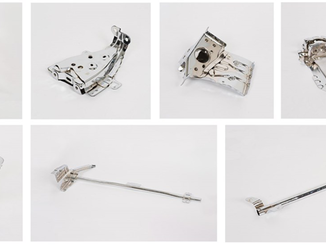
A new hot stamping process not only reduces space requirements and costs, but also eliminates the need for hot aging.
Components made of high-strength aluminum sheet are increasingly being used in vehicles to save weight. Schuler now offers a new hot forming process on hydraulic presses in which the light metal is heated within a very short time by means of contact heating and formed in a water-cooled die. All the process steps take place in the mold, so that unlike in the case of shape hardening of sheet steel, a separate furnace is no longer required.

© Schuler
“This not only reduces the space required for the line, but also the investment and operating costs quite considerably,” explains Christian Palm, who is responsible for hydraulic presses at Schuler. “This makes hot forming of aluminum a real alternative in sheet metal forming. The technology enables the production of lightweight and high-strength parts with significantly higher forming ratios compared to cold forming and much greater freedom in design.” The result is highly complex geometries and a tensile strength of 300 to 400 newtons per square millimeter.
In the process, heating plates integrated in the first forming stage heat aluminum sheet from the 6000 or 7000 series to over 300 to 450 degrees Celsius within a few seconds. In the second stage, the actual forming takes place in a water-cooled mold, while the next blank is already heating up at the same time. In a third and fourth stage, the component, which is still around 60 degrees, can then be trimmed.
On a 12,000 kilonewton hydraulic press from Schuler, cycle times of just ten seconds per part can be achieved in conjunction with a highly dynamic three-axis transfer. In contrast to previous methods for hot forming aluminum sheet, the components can be processed directly and do not have to be heat treated for several hours beforehand in order to harden. This once again noticeably reduces the production effort.
The first plant for an automotive supplier in Asia is already under construction. The parts made of high-strength aluminum that are created on it are destined for a manufacturer of electric cars.
Schuler will be presenting more on the new process for hot forming aluminum and other solutions for forming technology at the Blechexpo trade show from November 7 to 10 in Stuttgart (booth 8306).
Web:
www.schulergroup.com



